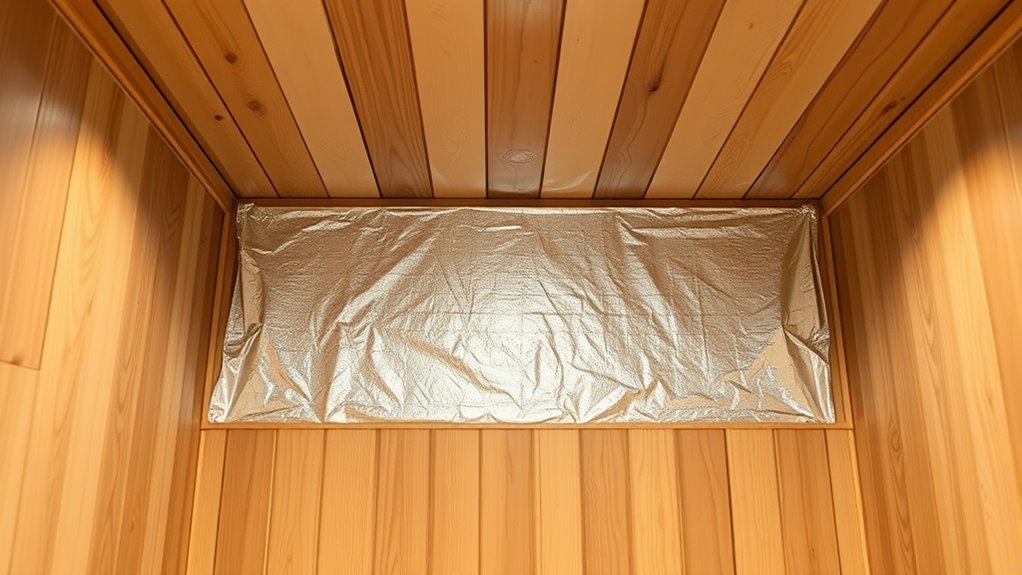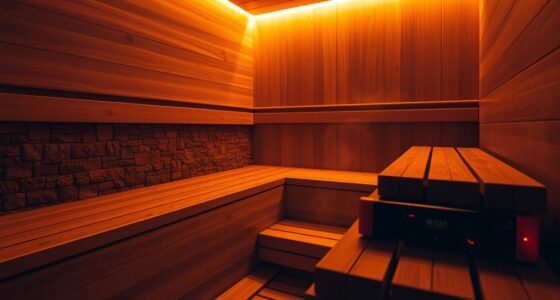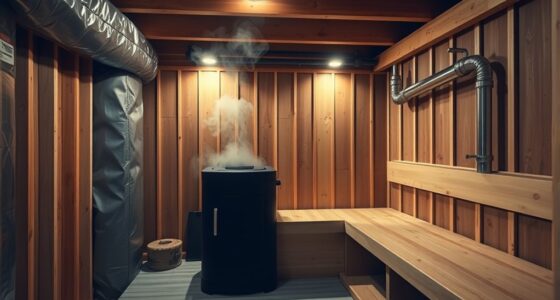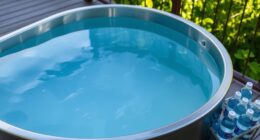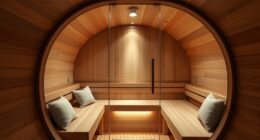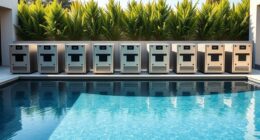To maximize energy efficiency in your sauna, focus on properly insulating the walls and ceilings with materials like rigid foam boards or mineral wool that resist moisture and provide excellent thermal resistance. Combine this with a moisture barrier such as vapor-retardant foil or film to prevent moisture from compromising your insulation. Good ventilation helps regulate humidity and temperature, preserving insulation quality. Keep in mind, effective sealing and regular maintenance will guarantee your sauna stays warm and energy-efficient longer—discover more tips to optimize your setup.
Key Takeaways
- Use high-quality insulation materials like mineral wool or rigid foam boards to maximize thermal resistance.
- Install a vapor-retardant barrier properly sealed around all edges to prevent moisture infiltration.
- Incorporate adjustable ventilation vents to regulate airflow and prevent humidity buildup.
- Leave small gaps between insulation and vapor barrier for air circulation and effective moisture control.
- Regularly inspect and maintain insulation and moisture barriers to ensure continuous energy efficiency.
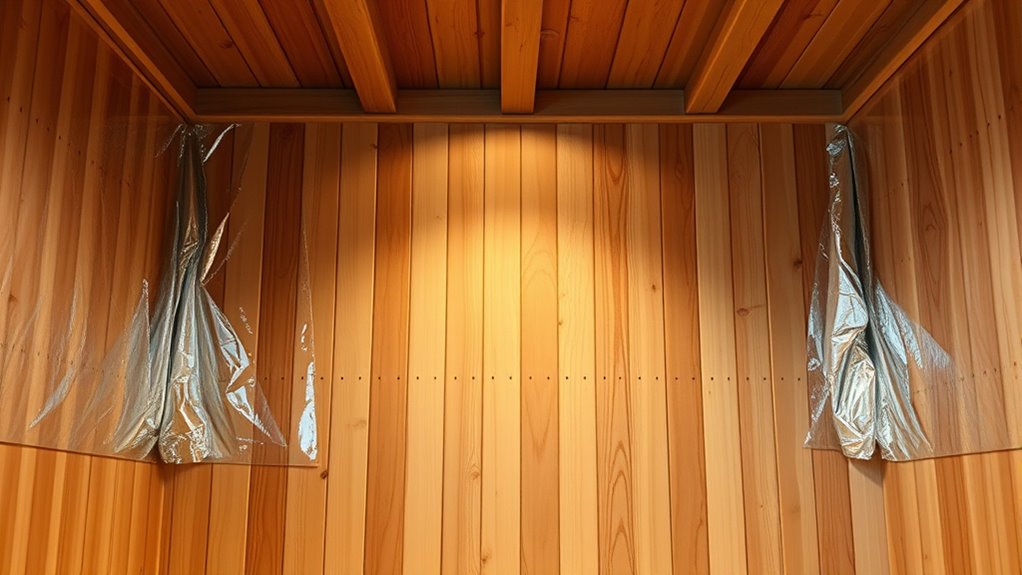
Insulating your sauna walls and ceilings is fundamental for maintaining consistent heat and improving energy efficiency. Proper insulation ensures the heat stays inside, reducing the workload on your heating system and lowering energy costs. To achieve this, you need to pay close attention to ventilation techniques and moisture barriers. Ventilation techniques are essential because they help regulate airflow, preventing excess moisture buildup that can damage insulation and structural components. Good ventilation allows fresh air to circulate without letting heat escape, which is critical in a sauna environment where humidity levels fluctuate. Incorporating effective ventilation techniques involves installing adjustable vents or air exchange systems that work with your insulation to maintain ideal conditions.
Moisture barriers are equally significant in insulating your sauna because they prevent moisture from penetrating the insulation material and the walls. When moisture seeps into insulation, it reduces its effectiveness, leading to heat loss and potential mold growth. A high-quality moisture barrier, such as a vapor-retardant film or foil, is installed on the warm side of the insulation to block moisture from passing through. The key is to guarantee these barriers are properly sealed around all edges and joints to create a continuous shield against humidity. This not only enhances energy efficiency but also extends the lifespan of your sauna’s structural elements.
When insulating, you should choose materials suited for high temperatures and humidity. Rigid foam boards and mineral wool are popular options because they offer excellent thermal resistance and moisture resistance. Make sure to leave a small gap between the insulation and the vapor barrier to allow for air circulation and prevent condensation. Proper installation techniques are critical—irregular gaps or poorly sealed seams can compromise the integrity of your insulation system. Always double-check that your moisture barriers are securely attached and that all penetrations, such as electrical outlets or vents, are properly sealed.
In addition to insulation, consider the placement of ventilation outlets and intakes to promote even airflow throughout the sauna. This helps prevent hot spots and ensures the humidity is evenly distributed and vented out efficiently. Regularly inspecting your sauna’s insulation and moisture barriers is also recommended, especially if you notice an increase in humidity or a drop in temperature consistency. By paying careful attention to ventilation techniques and moisture barriers, you maximize your sauna’s energy efficiency, reduce heating costs, and protect your investment for years to come. Incorporating high-quality comfort solutions can also enhance the overall sauna experience, making it more enjoyable and relaxing.
Frequently Asked Questions
How Often Should Sauna Insulation Be Replaced or Upgraded?
You should consider replacing or upgrading your sauna insulation every 10 to 15 years, depending on its insulation lifespan. Regular inspections help identify any signs of wear, such as moisture damage or reduced thermal performance. Upgrading insulation more frequently can improve energy efficiency and safety. Keep an eye on the condition of your insulation, and plan upgrades accordingly to maintain ideal sauna performance and energy savings.
Are There Eco-Friendly Insulation Options Suitable for Saunas?
Yes, eco-friendly insulation options are available for saunas. You can choose natural fibers like wool or cotton, which are sustainable and safe for high temperatures. Recycled materials, such as denim or cellulose, also work well and reduce environmental impact. These options not only insulate effectively but also promote eco-conscious living, helping you enjoy your sauna while minimizing your carbon footprint.
What Are the Fire Safety Considerations for Sauna Insulation?
You should prioritize fire safety by choosing insulation with high fire ratings and fire-resistant materials. Always check insulation fire ratings, ensuring they meet safety standards for saunas. Avoid materials that are highly combustible, and install fire-resistant barriers near heat sources. Regularly inspect your insulation for damage or deterioration. Using fire-resistant materials reduces the risk of fire, keeping your sauna safe while maintaining energy efficiency.
Can Insulation Affect the Sauna’s Humidity Levels?
Insulation’s permeability can influence your sauna’s humidity levels, creating a delicate balance between moisture retention and evaporation. While insulation helps control temperature, it can also affect humidity control if it’s too vapor-impermeable, trapping moisture inside. You need the right type of insulation to maintain ideal humidity, ensuring a comfortable experience without risking mold or damage. Proper ventilation and choosing appropriate insulation materials are key to managing humidity effectively.
Is Vapor Barrier Necessary Behind Sauna Insulation?
Yes, a vapor barrier is necessary behind sauna insulation. It prevents moisture from penetrating the insulation, which helps maintain its durability and effectiveness. Without it, humidity can cause insulation to deteriorate quickly, leading to reduced insulation performance and potential mold growth. Installing a vapor barrier ensures your sauna stays energy-efficient and safe, preserving the insulation’s longevity and keeping your sauna comfortable and well-maintained over time.
Conclusion
Insulating your sauna walls and ceilings boosts energy efficiency and keeps the heat where it belongs. Did you know that properly insulated saunas can reduce energy costs by up to 30%? By investing in quality insulation, you not only save money but also create a more comfortable, consistent heat experience. So, take the time to insulate well—you’ll enjoy warmer relaxations and lower bills for years to come.
